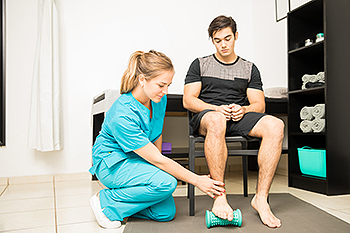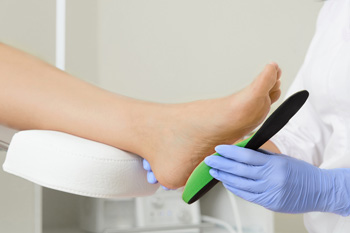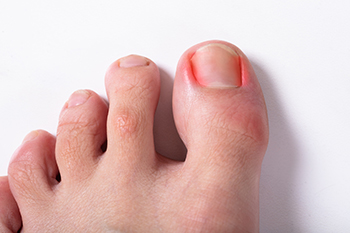Connect With Us
Blog
Items filtered by date: August 2022
Foot Stretches That May Help Plantar Fasciitis Pain

The plantar fascia is a thick band of tissue that is found on the sole of the foot, and connects the heel to the toes. An injury or repetitive stress may cause this area of tissue to become inflamed, and this is known as plantar fasciitis. Many people who are afflicted with this have severe pain and discomfort, and it is often difficult to walk. Symptoms can include a stabbing pain in the heel, which may be worse upon arising in the morning. When simple stretches are frequently practiced, they may help to reduce some of the discomfort caused by plantar fasciitis. A calf stretch is effective in strengthening the calf muscles. This is done by standing on a step, and lowering one heel at a time until a gentle stretch is felt. Some people find mild relief by placing the sole of their foot on a tennis ball, and rolling it for several seconds over the ball. Additionally, a towel crunch is practiced by placing a towel on the floor, and picking it up with the toes. If you would like more information about stretches to help reduce the pain from plantar fasciitis, please speak with a podiatrist.
Plantar fasciitis can be very painful and inconvenient. If you are experiencing heel pain or symptoms of plantar fasciitis, contact David Carmack, DPM from Texas. Our doctor can provide the care you need to keep you pain-free and on your feet.
What Is Plantar Fasciitis?
Plantar fasciitis is the inflammation of the thick band of tissue that runs along the bottom of your foot, known as the plantar fascia, and causes mild to severe heel pain.
What Causes Plantar Fasciitis?
- Excessive running
- Non-supportive shoes
- Overpronation
- Repeated stretching and tearing of the plantar fascia
How Can It Be Treated?
- Conservative measures – anti-inflammatories, ice packs, stretching exercises, physical therapy, orthotic devices
- Shockwave therapy – sound waves are sent to the affected area to facilitate healing and are usually used for chronic cases of plantar fasciitis
- Surgery – usually only used as a last resort when all else fails. The plantar fascia can be surgically detached from the heel
While very treatable, plantar fasciitis is definitely not something that should be ignored. Especially in severe cases, speaking to your doctor right away is highly recommended to avoid complications and severe heel pain. Your podiatrist can work with you to provide the appropriate treatment options tailored to your condition.
If you have any questions, please feel free to contact our office located in Marble Falls, TX . We offer the newest diagnostic and treatment technologies for all your foot care needs.
We Can Treat Your Foot or Ankle Pain
Orthotics for Overpronation

Orthotics are shoe inserts that can be recommended to correct problems in your gait or the structure of your feet. Overpronation is one kind of gait issue that can potentially be corrected with the use of orthotics. An individual has overpronation when their feet excessively roll inward during walking or running for shock absorption purposes. Overpronation ultimately puts unnecessary pressure both on the big toe and on the entire inner foot. To correct overpronation before it leads to other complications, you might use orthotics. Custom-made orthotics that are specifically fit to your foot type may be able to restrict the extent to which your foot rolls inward through arch support padding. To reduce strain on your ankle from overpronation, orthotics can redistribute and reallocate the pressure you put on your feet. Orthotics might even have heel wedges to restrict how much the heel moves forward when the feet are in motion. However, it is important to note that in some cases orthotics alone might not completely correct and eliminate your overpronation. If you have overpronation and are interested in possibly using orthotics, contact your podiatrist for help.
If you are having discomfort in your feet and would like to try orthotics, contact David Carmack, DPM from Texas. Our doctor can provide the care you need to keep you pain-free and on your feet.
What Are Orthotics?
Orthotics are inserts you can place into your shoes to help with a variety of foot problems such as flat feet or foot pain. Orthotics provide relief and comfort for minor foot and heel pain but can’t correct serious biomechanical problems in your feet.
Over-the-Counter Inserts
Orthotics come in a wide variety of over-the-counter inserts that are used to treat foot pain, heel pain, and minor problems. For example, arch supports can be inserted into your shoes to help correct overarched or flat feet, while gel insoles are often used because they provide comfort and relief from foot and heel pain by alleviating pressure.
Prescription Orthotics
If over-the-counter inserts don’t work for you or if you have a more severe foot concern, it is possible to have your podiatrist prescribe custom orthotics. These high-quality inserts are designed to treat problems such as abnormal motion, plantar fasciitis, and severe forms of heel pain. They can even be used to help patients suffering from diabetes by treating foot ulcers and painful calluses and are usually molded to your feet individually, which allows them to provide full support and comfort.
If you are experiencing minor to severe foot or heel pain, it’s recommended to speak with your podiatrist about the possibilities of using orthotics. A podiatrist can determine which type of orthotic is right for you and allow you to take the first steps towards being pain-free.
If you have any questions, please feel free to contact our office located in Marble Falls, TX . We offer the newest diagnostic and treatment technologies for all your foot care needs.
The Inconvenience of an Ingrown Toenail

An ingrown toenail can make putting on a pair of shoes or walking difficult. While it is not a serious problem, it is an irritating one and something that can turn into an infection if not tended to. Healthy toenails grow out and away from the base of the nail bed. An ingrown toenail is when the toenail grows into the side of the cuticle. In severe cases, the skin will fold over the nail. Ingrown toenails typically happen on the big toe. The skin tissue at the cuticle will become red, sensitive, and inflamed, and there may be weeping pus. Some ingrown toenails are easy to treat by soaking in various oil or salt preparations and gently pulling the nail away from the skin, while others require minor surgery. While the ingrown nail is healing, it is important to trim the nail straight across. If the ingrown toenail is too painful to trim or if an infection develops, see a podiatrist as soon as possible who can do what is necessary—even a minor surgical procedure with a local anesthetic—to get you on the right track.
Ingrown toenails can become painful if they are not treated properly. For more information about ingrown toenails, contact David Carmack, DPM of Texas. Our doctor can provide the care you need to keep you pain-free and on your feet.
Ingrown Toenails
Ingrown toenails occur when a toenail grows sideways into the bed of the nail, causing pain, swelling, and possibly infection.
Causes
- Bacterial infections
- Improper nail cutting such as cutting it too short or not straight across
- Trauma to the toe, such as stubbing, which causes the nail to grow back irregularly
- Ill-fitting shoes that bunch the toes too close together
- Genetic predisposition
Prevention
Because ingrown toenails are not something found outside of shoe-wearing cultures, going barefoot as often as possible will decrease the likeliness of developing ingrown toenails. Wearing proper fitting shoes and using proper cutting techniques will also help decrease your risk of developing ingrown toenails.
Treatment
Ingrown toenails are a very treatable foot condition. In minor cases, soaking the affected area in salt or antibacterial soaps will not only help with the ingrown nail itself, but also help prevent any infections from occurring. In more severe cases, surgery is an option. In either case, speaking to your podiatrist about this condition will help you get a better understanding of specific treatment options that are right for you.
If you have any questions please feel free to contact our office located in Marble Falls, TX . We offer the newest diagnostic and treatment technologies for all your foot and ankle needs.
Why Your Feet May Ache at Night

About 20 percent of people complain about foot pain at night, especially women, people over 50, and those who are overweight. Among the many possible causes are wearing high heels, standing for long periods at work, and nerve damage. Cramps and spasms may be the result of muscle fatigue, sitting for long periods, or wearing tight shoes. Chemical changes in the body during pregnancy can also cause cramping. A number of foot-related conditions may also result in nighttime foot pain. Among them are Morton’s neuroma, plantar fasciitis, fibromyalgia, and peripheral neuropathy. Diabetes can also be a major source of foot pain, as reduced blood circulation can cause muscle pain in the feet. The first and easiest remedy for recurring foot pain is to check your footwear. Find shoes that cushion the feet and offer ample room for the toes. There are a number of exercises, as well as certain medications, that can help reduce foot pain. If your nighttime foot pain worsens, please consult a podiatrist as soon as possible. They can conduct a complete exam to determine the cause and offer the appropriate treatment plan.
Foot Pain
Foot pain can be extremely painful and debilitating. If you have a foot pain, consult with David Carmack, DPM from Texas. Our doctor will assess your condition and provide you with quality foot and ankle treatment.
Causes
Foot pain is a very broad condition that could be caused by one or more ailments. The most common include:
- Bunions
- Hammertoes
- Plantar Fasciitis
- Bone Spurs
- Corns
- Tarsal Tunnel Syndrome
- Ingrown Toenails
- Arthritis (such as Gout, Rheumatoid, and Osteoarthritis)
- Flat Feet
- Injury (from stress fractures, broken toe, foot, ankle, Achilles tendon ruptures, and sprains)
- And more
Diagnosis
To figure out the cause of foot pain, podiatrists utilize several different methods. This can range from simple visual inspections and sensation tests to X-rays and MRI scans. Prior medical history, family medical history, and any recent physical traumatic events will all be taken into consideration for a proper diagnosis.
Treatment
Treatment depends upon the cause of the foot pain. Whether it is resting, staying off the foot, or having surgery; podiatrists have a number of treatment options available for foot pain.
If you have any questions, please feel free to contact our office located in Marble Falls, TX . We offer the newest diagnostic and treatment technologies for all your foot care needs.
Blog Archives
- December 2025
- November 2025
- October 2025
- September 2025
- August 2025
- July 2025
- June 2025
- May 2025
- April 2025
- March 2025
- February 2025
- January 2025
- December 2024
- November 2024
- October 2024
- September 2024
- August 2024
- July 2024
- June 2024
- May 2024
- April 2024
- March 2024
- February 2024
- January 2024
- December 2023
- November 2023
- October 2023
- September 2023
- August 2023
- July 2023
- June 2023
- May 2023
- April 2023
- March 2023
- February 2023
- January 2023
- December 2022
- November 2022
- October 2022
- September 2022
- August 2022
- July 2022
- June 2022
- May 2022

